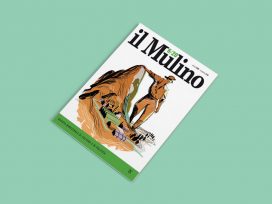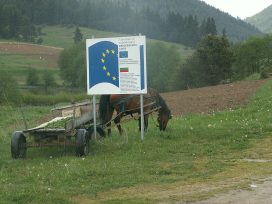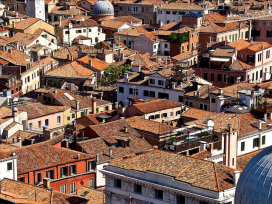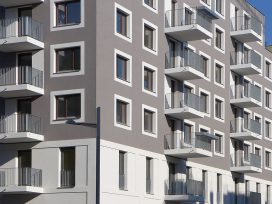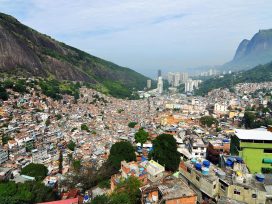What kind of city is Prishtina, capital of Kosovo? This fairly small but congested city may, to a visitor, seem disconcertingly difficult to grasp and describe. It is both an erratically modernizing city while at the same time appearing ordinary, worn-down and polluted. It is a city one “loves to hate” as one of the few tourist guidebooks describes it. But how does everyday life evolve in this urban space?
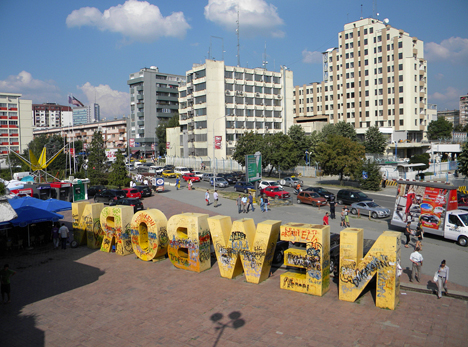
Newborn monument, Pristina, Kosovo, Serbia, 2012. Photo: Timon91. Source:Flickr
There are varying theoretical approaches to studying the city, the formations of its places and the different ways these are used by residents and visitors over time. For anthropology, the comparative study of cultural meanings of time and place and the formations of everyday life are integral to its theoretical and ethnographic endeavour. In some sense, this relates to Lefebvre’s conceptions of time and rhythm in relation to everyday life. However, it is in the study of people’s concrete, ongoing social interactions and experiences that anthropological knowledge is created, whether in villages or cities.
A number of analytical themes in the social sciences have informed studies of cities: ethnicity, division/segregation, gender, globalization, planning, to name a few (Low 1999: 5). Some would rather conceptualize Prishtina as a “post-conflict” city, a designation that has emerged also in various studies of architecture and planning (Bacic 2009, Shirlow 2006, Vöckler 2008). However, as with any categorization, the boundaries of meaning, of time and place, become blurred. When does the “post-conflict” matter, and how? In the case of present Prishtina, post-conflict mainly refers to the most recent conflict, the war in Kosovo with Serbia in the late 1990s. It is a reference to architectural and societal destruction and the radical change of policies, the influx of internally displaced persons from rural areas, the impact of international aid personnel, and to the (re)construction following the years of repression that led up to the war. Through the years, different forms of construction and destruction have been formative and transformative of Prishtina, and this history is part of what goes into the post-conflict city of today. It is not merely about linear historical time, but temporal scale of experiences, memories, and the rhythms of everyday life as they take place.
Prishtina has a long history, although this may be hard to believe as one walks about the town. For many centuries it has been an inhabited area, developing from a village in close proximity to greater Roman and Byzantine cities to a centre of crafts, trade and mining from at least the fourteenth century until the early 1900s when the Ottoman rule of the Balkans came to an end and Kosovo came under Serb rule as part of the Kingdom of Yugoslavia, and after WWII the socialist federation of Yugoslavia under Tito, and subsequently the more sinister rule that developed after the death of Tito in 1980 (Malcolm 1998). Prishtina became the capital of the province of Kosovo shortly after WWII.
In the name of modernization and urban development in the 1950s, the well-known slogan was “destroy the old, build the new” (Allcock 2001, Herscher 2010, Vöckler 2008, Gartska 2010). The destruction of the old included one of the largest covered bazaars in the region, an Ottoman hamam and a large number of Ottoman town houses. In addition the main Catholic church and the synagogue were destroyed alongside some mosques. These gave way to the construction of modern apartment and office buildings, and the laying of roads. Today there are several signs of the kind of heavy-set architectural constructions of the time.
All through the 1990s, the fateful decade of the break-up of Yugoslavia, the wars and the repression and the “policy of neglect” of the Milosevic regime, Prishtina fell into disrepair, schools were segregated and Albanians were discharged from employment on a huge scale. After NATO troops bombed Serb targets and entered Prishtina in June 1999, demonstrably ending the war, the many thousand Albanians who had fled, or been deported, returned, as did a great number of rural inhabitants who had lost their homes during the war of 1997-99 and sought housing in Prishtina. Most Serbs and Roma fled Prishtina after the war, leaving their houses and apartments. Kosovo became a UN protectorate for the following decade. In 2008, after several years of discussions about the future status of Kosovo the Kosovo Assembly took matters into their own hands and unilaterally declared Kosovo independent, constituting the newest state in Europe. To celebrate this event, a huge yellow-painted metal monument of block letters forming the English word “NEWBORN”, was erected. A new future! And a new kind of monument, not the usual statue of a heroic fighter. Young people climbed all over the letters writing their names and dates. Now several years later, the monument is still standing, receiving more and more inscriptions of names and dates, but the celebration of a new beginning and a promising future for Kosovo – which was never shared by the small Serb and Roma population – has for many Albanians more or less crumbled. Unemployment is extremely high, wages and social welfare are very low and many people live in very poor conditions, whereas others are steadily increasing their assets; and corruption has spread.
The largely unregulated building boom has expanded the city into the surrounding, previously agricultural land, as well as densifying and remaking central parts of the city. The style of buildings in the wake of this intensive construction is characterized by a seemingly random and informal jumble of styles, which is recognizably global in its scope. In relation to the global expansion of a financially run market economy, much wealth is invested and flaunted in construction in many parts of the world. As one architect engaged in urban development in the Balkans phrases it, it is an “informalization of the urban space caused by a kind of unfettered, neoliberal capitalism” (Vöckler 2008: 12). Government policies are often opportunistically compliant and political resistance to the exploitation of land and property is weak or suppressed.
As this high-speed change is taking place, both local and international critics are particularly worried about the ongoing destruction of the old town, also that building security and infrastructure adjustments such as sewage, road width, garbage management, are often more or less ignored, which underscores potential dangers and future costs, and environmental degradation. Although Prishtina’s streets and buildings were neglected all through the 1990s, critics argue that the main destruction of the city happened after the war through unregulated construction. The war in Kosovo brought great destruction to the rural areas, as did the war in Bosnia (Bringa 1995, Duijzings 2010). Rural homes were systematically destroyed as part of the logic of the military violence (Herscher 2010), whereas buildings in Prishtina were on the whole not targeted.
As is recognizable from other conflict and post-war areas, with the destruction of not only buildings and roads but general infrastructure and many social institutions, reconstruction becomes the scene of conflicting or overlapping interests from that of international aid programs to national and international construction tycoons (Archis 2007: 66). Reconstruction funds through international donors, as the general presence of a great number of Internationals, UN and EU personnel especially, but also the huge number of relief workers and NGOs, have demanded housing, offices and military complexes, resulting in a significant impact on both house-building and the renovation of buildings in the central parts of the city. For many residents, letting their houses or apartments to the internationals, has been a source of income although the demand in later years has diminished and locals or new residents from rural areas are unwilling or unable to pay the rents required. This international presence has contributed to the rise of prices for both housing and general consumption. “(I)n looking at Prishtina, it can be seen that the untaxed and unregulated city planning is the result of a political and social crisis that is typical of post-conflict situations” (Vöckler 2008: 20).
Space is open to contests of power and more or less crude economic gain. With a weak urban planning ministry and prolific corruption constructors, politicians have built with little restraint. To the extent that Kosovo architects engage in planning issues, little of their critique has been adhered to. Public protests among residents have not been organized against lack of urban planning or the construction of illegal buildings, nor against the political preference for roads and traffic and shopping malls over the construction of good, well-planned housing and work-places. Instead people may be heard complaining over misplaced expenditures, high prices, and blaming the Internationals or, more specifically, the EU, or Saudi Arabia and their incessant investments in mosques instead of factories. To be sure, many ordinary residents and in-movers have an interest in not pushing the issue since they may also have built their homes without formal approval.
In this article, I attempt to show some of the various ways everyday perceptions and practices of Prishtina’s different categories of residents and temporary visitors work themselves into the formation of this urban space, caught as they are in the interstices of processes of destruction and (re)construction.
A neighbourhood of standing and wear
In its heavy-set spaciousness and seeming ordinariness, the partly worn-down neighbourhood of Dardania in central Prishtina was built primarily during the 1960s-70s in the modernistic socialist mode and is closely connected to the housing construction era of the Yugoslav period. With some thousand residents it lies between the two main avenues cutting through the centre of Prishtina. One of them renamed after the war as Bill Clinton Avenue. The other is Mother Teresa Avenue, with the huge newly built Catholic cathedral at the main intersection. Recently Clinton also received a more tangible homage with his statue erected along the Avenue. Within the bounds of the area are an old passage, a gallery of shops and cafés, small grocery stores and numerous parking lots where large open garbage bins intersperse the ground. Two primary schools are surrounded by the eight or nine story apartment buildings. Recently, an open space (a neglected barren field), was turned into a park, with grass lawns, newly planted trees and stone-set pathways with benches placed alongside. Old and young frequent this space and it is becoming incorporated into leisure everyday practices. Older people are thereby reminded of how during Tito’s rule Dardania was generally better kept – there were many trees and bushes and the numerous Serb neighbours were orderly and polite, however since the war they have all left. A nostalgia for Yugoslavia is sometimes heard when long-term residents compare their situation of today with before the war – para luftes and mas luftes, before and after the war. These are the most common definers of events over time among people I have spoken to. The freedom that the war was to bring has not resulted in economic security and good, well-functioning infrastructure, nor a reliable political elite or good neighbours.
Local mobility: From home to house
A family of five that I came to know lived for many years in a two-room flat in Dardania, which the husband received as state employee in line with former Yugoslav policy. Around 2007, the family decided to sell the apartment in Dardania and move to a house in the outskirts of the city, a house they had been building for the last three or four years. Like most others in this new neighbourhood, they built without a formal land deed or building permit from the municipality. During that time more houses were built up the hill, despite the steep road being almost impassable until recently. Houses near the road have been built too close to each other and to the road, something typical of these newly expanding areas.
This family shares many aspects of family mobility with other Prishtina residents, both in terms of movement and status position. In the early 1990s the husband migrated to Germany to find work; he had been sacked by the Serb government, as most other Albanians in those years. The family was reunited only in 1999 in a refugee camp. Together they returned to Kosovo and their looted and partly demolished apartment in Dardania.
The wife had often missed Dardania because her friends and neighbours, with whom she had also experienced the war, were there. They would come to visit, drink coffee and smoke, they could take walks around the neighbourhood and stores were close at hand. “But what can you do?”, she sighs. After spending years working abroad, leaving a family behind, and now with a son soon to be married you need a big house. As social and economic asset and as the basis for the reproduction of family relations, the house is of central importance. Big expensive houses are in many places “the primary signs of upward mobility and there is great pride in showing them off” (Åkesson 2004: 130). This form of mobility also contributes to the changing face of Prishtina, creating new neighbourhoods, new social relations and a continued reliance on migrants’ remittances.
Naming and remembering, a pre-war childhood in Dardania
Urban life is not only about housing in terms of building and creating family and public space. The city is also about meaning – making through memories of places, local names, and through different kinds of work and play. Neither are urban places accessible in similar ways by all those who move and live there. Relations of age and gender, and ethnicity, play a part in creating the public spaces. Taking children’s experiences, how do they interpret and use the urban spaces where they dwell and move? How do they transform such spaces into their places confronted as they are by conflicting adult views, and the confounding consequences of economic and political interests?
A young man, Albin, was born in the early 1980s and has lived his whole life in Dardania with his parents and older brother in a two-room apartment. “During my childhood, I did not know what ‘Dardania’ meant”, he says. “At first it depicted something good, then it was something dangerous and we could not use the name”, he continues. He later learned that Dardania referred to the ancient Kosovo territory of Dardane, populated by the Illyrian tribes. The Albanian resistance movement in the 1990s also cultivated “the spirit of Dardany”, he says. Albin had great problems getting used to some of the names that they had to call places in the neighbourhood. “I did not know much about the boundaries of my neighbourhood. Even today, I can’t really define them. When my friends and I wanted to play outside or go somewhere around in the area we used our own names. Even though adults, parents and neighbours expected us, more or less forced us, to use national names”.
Knowing the distinction between the front yard and the backyard, was for Albin and the other children, of much greater importance. The distinction between them was like a code. “If you mixed them up, you could lose your place in a game, because these distinctions of space denoted the place of the games, also what type of games and which friends would usually participate”. An important reason for playing in this backyard was its closeness to their housing area. There they were, to some extent, protected against threats from Serb police, and the hot summer sun. “These two areas, the back yard and the front yard were the most important places of my childhood outside school.”
The politicized interpretations and uses of history make themselves felt through adults’ naming and boundary-making which stands in an ambiguous and sometimes threatening relation to children’s realms of understandings and constructions of everyday places. With that perspective, places are always given meaning and in turn form meanings as they are acted upon, and remembered (Fog Olwig and Gullöf 2003, Gilliam 2003).
Waste, work and identity: Roma in Dardania
Distinctions of belonging and social identity both form and are formed by how and where people use public space. The Roma have the most precarious position in Kosovo (cf. Syla 2009). Before the war some Roma were residents of Prishtina but no more – they have fled or been moved to enclaves or camps outside Prishtina. Roma are, however, still part of Prishtina’s public space. Together with family members, many travel every day from a neighboring town to Prishtina to collect scraps of iron, plastics and other useful items. These are later sorted and sold at a junkyard. Since the garbage containers are in parking lots they are good places to park a small vehicle should one be lucky enough to own one.
As a case in point, in a parking lot in Dardania an elderly man parks his small green pick-up truck daily and the family members disperse to collect iron scraps. Some of their children are brought along to guard the truck lest their accumulating goods be stolen. The children’s task means that they must stay put until the family members return. It is boring and tiresome for them and it makes them easy targets of the neighboring Albanian children’s taunts, but they keep their distance and are admonished to never let themselves be provoked.
This family lives outside Prishtina, close to huge, abandoned factory buildings, railroad tracks and wide, muddy fields and narrow roads and alleys. All the friends and neighbours are Roma, many of them relatives. This is quite a different experience of place for the children than in Dardania. The children always congregate outdoors – there is a big open public space where they play football and other games. There are also a number of empty houses in the neighbourhood, some of them belonging to their neighbours living abroad as refugees. All these houses serve as secret places for the children where they can stay and play unobserved by the adults. Here they are in control and create their own boundaries, much as Albin and his friends in Dardania. Given the unequal power relations that have throughout history been a part of Roma experiences they protect themselves by keeping the Albanians ignorant of their way of life. They come to Prishtina and make Albanians’ garbage useful while guarding their own space from intrusions (cf. Jaffe and Dürr 2010).
Conclusion
As the ethnographic examples show, residents of Prishtina set their mark on the cityscape through their small-scale everyday practices and uses of urban places. Different categories of persons will experience and use the city in differing ways and rhythms according to their age, gender, class, ethnicity. These experiences and meanings of time and space are not always reconciled with those set by policies and capital – which nonetheless condition the everyday in many ways (Lefebvre 2004; cf. Butler 2012). An important aspect of the construction boom in this context is that it has been a major source of income for unemployed men from mainly rural areas in the last decade, there have been few other routes for work and profit. However the debris produced becomes a source of income for Roma, who are in other ways excluded. Another factor of significance has been that migrants abroad have primarily invested in house building for their resident families and for themselves in Prishtina as elsewhere in Kosovo. In addition, many families from rural areas have sought housing in Prishtina after the war since so many rural houses were destroyed. These recent post-war rural residents have taken over apartments, either legally or illegally and have contributed in the remolding of Prishtina’s population structure. As for children, often overlooked in urban studies, they use places that they interpret and manage and transform in accordance with, or in opposition to, the constraints, ideals and relations of which they are a part. Not so differently from what adults do, but from a different vantage point, with different experiences to put to use, and different positions in the hierarchy of authority. This can contribute to a deeper insight into the relations between everyday life and the political and economic structures that make up the city.
Bibliography
Allcock, John (2000): Explaining Yugoslavia. London: Hurst & Company.
Archis (2007): Cities unbuilt. Special project issue. In: Archis, Volume 11, 66-93.
Åkesson, Lisa (2004): Making a life. Meanings of migration in Cape Verde. Gothenburg University, unpublished PhD thesis.
Bacevic, Jana (2009): Kosovo: Myths and reality. Available from: http://www.balkaninsight.com/en/blog/kosovo-myths-and-reality
(2009-04-16).
Bringa, Tone (995): Being Muslim the Bosnian way. Identity and community in a central Bosnian village. Princeton, NJ: Princeton University Press.
Butler, Chris (2012): Henri Lefebvre. Spatial politics, everyday life and the right to the city. London: Routledge.
Duijzings, Ger (2010): From Bongo Bongo to Boston via the Balkans. Anthropological contributions to the study of urban transformations in southeastern Europe. In: Bohn, Thomas and Calic, Marie Janine (Eds.): Urbanisierung und Stadtentwicklung in Südosteuropa vom 19. Bis zum 21. Jahrhundert. München: Otto Sagner Südosteuropajahrbuch, 37, 93-132.
Dürr, Eveline and Rivke Jaffe (Eds.) (2010): Urban pollution. Cultural meanings, social practices. NY/Oxford: Berghahn Books.
Fog Olwig, Karen and Gullöf, Eva (Eds.) (2003): Children’s places. Cross-cultural perspectives. London: Routledge.
Gartska, Grant Jude (2010): Post-conflict urban planning. The regularization process of an informal neighborhood in Kosova/o. In: Habitat International, 34: 86-95.
Gilliam, Laura (2003): Restricted experiences in a conflict society: the local lives of Belfast children. In: Fog Olwig, Karen and Gullöf, Eva (Eds.): Children’s places. Cross-cultural perspectives. London: Routledge.
Herscher, Andrew (2010): Violence taking place. The architecture of the Kosovo conflict. Stanford, California: Stanford University Press.
Marzouk, Lawrence and Aruqaj, Bujar (2012): Soaring pollution costs Kosovo the earth. Available from: http://www.balkaninsight.com/en/article/soaring-pollution-costs-kosovo-the-earth (2012-22-06).
Lefevbre, Henri (2004): Rhythmanalysis. Space, time and everyday life. London: Continuum.
Low, Setha (1996): The Anthropology of cities. Imagining and theorizing the city. In: Annual Review of Anthropology, Vol 25: 383-409.
Malcolm, Noel (1998): Kosovo. A short history. MacMillan.
Shirlow, Peter (2006): Belfast. The post-conflict city. In: Space and Polity, Vol 10, 99-107.
Syla, Driton (2009): Camps of Shame. In: Periskopi, 1. Prishtina: Foreign Policy Club, 1-9.
Vöckler, Kai (2008): Prishtina is everywhere. Turbo urbanism, the aftermath of a crisis. Amsterdam: Stichting Archis.
